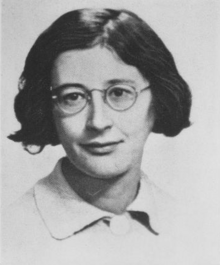The blur is not just a contradiction (Simone Weil)
With my development of the blur as an intentional way of thinking, with regard to categories or routines of thought and language, I have discovered prior art which is either allied or bears striking similarities. Striking in the sense that they show a similar stance or attitude to: paradox, mystery, holism, emergence with any way of knowing (meaning broadly, holding in mind) and uses this stance as a creative act, with or without a phenomenological method.
See the linkpost page for an introduction to the blur as I attend to it, with links to other discussion about this attentive state of mind. In addtion this is developed in relation to the… —gap, with regard to aporia, paradox, and our eagerness to fill it up or cover it over, with which the contemplation of contradiction is kin.
There is usually some aspect of these phenomenalogical espitemological methods which facets truth or wisdom. Either by grinding at it, or living it.
In this essay I look at Simone Weil and her use of contradiction as introduced to her by René Le Senne at. I’ll be following a pathway laid out by the text at https://plato.stanford.edu/entries/simone-weil/
This 'essay' draws from written notes, from July 2023, made on a printed version of that Stanford webpage. This was at the same time as The need for worlds was being prepared looking at Simon Weil’s book The need for roots (substack.com posting.)
I will write as if one knows my blur quite well (sorry about that), it is from this method I look at Simone Weil's contemplation of logical contrictions.
The blur is less reliant on waiting for a contradiction to be noticed. The blur does not require contradiction, nor does it avoid it.
Following René Le Senne, Simone Weil used the epistemological thesis that contradictions as obstacles allows us to generate more nuanced thinking, while alerting us to the notion, and thus the working possibility, that we may need to reappraised our assumptions or frameworks.
The contradiction as obstacle is more a psychopomp than a satan.
The contradiction is an opportunity. (This is not very Catholic if the primary virtue is obedience.)
The [slashing blur] also allows one to “contradict” in the sense of a superpositional attention, at any time, regardless of whether any two categories or datums are in any relationship, logical or not, at all.
See also: contronyms, dedifferentiation, derangement, and ¿joint attention?
The contradiction as a term is also in danger of subsuming itself to a Hegelian dialectic framework where thesis/antithesis lifted themselves up into a synthesis, which is just another category. We enter a Vahalla where the unmourned dead rise again to battle in the morning of synthesis. The karmic weel is not stilled. Here it is a feature not a bug.
Weil rejects this logicalism as it averts its eyes from mystery. As Weil puts it forward, the knower, in acknowledging contradiction, is then lead by the contradiction, on to a higher contemplation of truth-as-mystery, which, ‘sort of’, throws the gap into the… —gap, and kindly gives us a certain unity of the incommensurables, which is a mystery we can apprehend (in our souls) but not comprehend (in logicalism). Here reason is more than rationalising.
So throw 'it' in the gap, and some will practice it until one has visions
“I want to believe” ∴ I am special ∴ I am being/soul/form/god”
The special here is a by-product of the worlding urge, if not given away to grandchildren it can destroy us with bad worlding →world-building : ideology/dogma/loss-of-perspective by supersaturating our own selves with our own point-of-view. Own-ness doubled-down on never gets to two.
This is too much. Even without that rash selfishness.
The Christ figure appears to save us with/in its mystery of salvation, for example in the command of contradiction to “love your enemies”. This, I feel, is a somewhat tenuous exertion of the worlding urge. Diaphanous even. A superposition of assumed harmony beyond our mortal frailties, beyond our failing sinful natures, a superposition that never collapses into our mere impure realities. Perhaps that last straw of hope is its attraction.
As such, it is an attitude, much like the intentional attitude of prayer of the devotee or obedient servant, but less than the practice of meditation. The world is held in mind, but then ignored for the shiny things of traditional interpretations, or that sparkle or move us more recently, distracting direct-attention away from the worlding urge itself for the talisman (the Christ figure). A bait and switch politicians can never resist.
I think the blur as a suspension of judgment allows a better cognizance of our frames and our biases, even as they compose us in confounding ways. Wiser.
There is no doubt that Weil’s use of these contradictions are heavily framed by her worlding urge, as her wisdom allows some regulation, some self-regulation, of these mystery-cult contradictions of some higher form that the ‘soul moves us towards…’ in her use of the practice of reading.
I’ll cover that next in Reacting to reading of a reading of Simone Weil writing about reading

Crossposted on substack.com.
